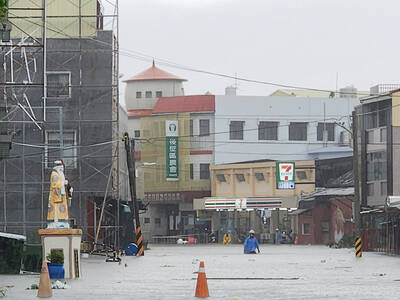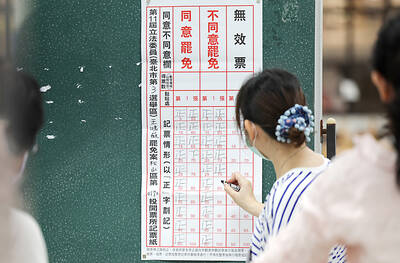Taiwan’s economy expanded by a stronger-than-expected 7.96 percent in the second quarter, the fastest pace since the second quarter of 2021, fueled by surging exports of high-tech products and robust capital formation, the Directorate-General of Budget, Accounting and Statistics (DGBAS) said yesterday.
The figure far exceeded the agency’s May projection of 5.23 percent and places Taiwan well ahead of regional peers, the agency said.
South Korea saw 0.5 percent growth, Hong Kong 3.1 percent and Singapore 4.3 percent during the same period, it added.

Photo: CNA
Second-quarter GDP per capita rose to a record NT$294,237 (US$9,835), signaling continued resilience amid external uncertainties, it said.
“The better-than-expected performance was largely fueled by a surge in exports and stronger-than-forecast capital formation, including fixed investments and inventory buildup,” DGBAS senior executive officer Chiang Hsin-yi (江心怡) said.
On a seasonally adjusted annualized rate, Taiwan’s GDP soared 12.89 percent, reinforcing the strength of the recovery, DGBAS data showed.
Exports were the standout driver. In US dollar terms, outbound shipments surged 34.06 percent year-on-year in the April-to-June period, buoyed by global demand for artificial intelligence (AI) applications and advanced tech components, the DGBAS said.
In real terms, exports of goods and services — adjusted for inflation and ownership changes — surged 35.1 percent, beating a previous estimate of 28.52 percent, it said.
The spike partly reflected front-loading by global clients ahead of potential US tariffs, the agency said.
Imports also gained momentum, rising 24.54 percent year-on-year, led by a 55.11 percent increase in capital equipment, as manufacturers ramped up investment, the DGBAS said, adding that real imports of goods and services advanced 31.95 percent, further supporting domestic production.
As a result, net external demand contributed 5.77 percentage points to last quarter’s GDP growth, up from the previous estimate of 4.83 percentage points, it said.
While capital formation added 1.56 percentage points, Chiang said that was a deceleration compared with earlier quarters, due to a high base from the previous year.
Nonetheless, domestic investment remained solid, underpinned by long-term corporate strategies, Chiang added.
Chiang declined to comment on whether GDP growth this year could exceed 3 percent, saying that the agency’s figures are subject to revision this month.
However, major institutions, including Barclays PLC, Citigroup Inc, DBS Bank Ltd and the Asian Development Bank, forecast that GDP would grow between 2.8 and 4 percent this year, Chiang said.
“Even if exports face tariff headwinds in the second half of the year, their momentum is unlikely to vanish overnight,” she said, citing the structural strength of Taiwan’s tech sector and persistent capital expenditure.

Rainfall is expected to become more widespread and persistent across central and southern Taiwan over the next few days, with the effects of the weather patterns becoming most prominent between last night and tomorrow, the Central Weather Administration (CWA) said yesterday. Independent meteorologist Daniel Wu (吳德榮) said that based on the latest forecast models of the combination of a low-pressure system and southwesterly winds, rainfall and flooding are expected to continue in central and southern Taiwan from today to Sunday. The CWA also warned of flash floods, thunder and lightning, and strong gusts in these areas, as well as landslides and fallen

WAITING GAME: The US has so far only offered a ‘best rate tariff,’ which officials assume is about 15 percent, the same as Japan, a person familiar with the matter said Taiwan and the US have completed “technical consultations” regarding tariffs and a finalized rate is expected to be released soon, Executive Yuan spokeswoman Michelle Lee (李慧芝) told a news conference yesterday, as a 90-day pause on US President Donald Trump’s “reciprocal” tariffs is set to expire today. The two countries have reached a “certain degree of consensus” on issues such as tariffs, nontariff trade barriers, trade facilitation, supply chain resilience and economic security, Lee said. They also discussed opportunities for cooperation, investment and procurement, she said. A joint statement is still being negotiated and would be released once the US government has made

MASSIVE LOSS: If the next recall votes also fail, it would signal that the administration of President William Lai would continue to face strong resistance within the legislature The results of recall votes yesterday dealt a blow to the Democratic Progressive Party’s (DPP) efforts to overturn the opposition-controlled legislature, as all 24 Chinese Nationalist Party (KMT) lawmakers survived the recall bids. Backed by President William Lai’s (賴清德) DPP, civic groups led the recall drive, seeking to remove 31 out of 39 KMT lawmakers from the 113-seat legislature, in which the KMT and the Taiwan People’s Party (TPP) together hold a majority with 62 seats, while the DPP holds 51 seats. The scale of the recall elections was unprecedented, with another seven KMT lawmakers facing similar votes on Aug. 23. For a

SOUTH CHINA SEA? The Philippine president spoke of adding more classrooms and power plants, while skipping tensions with China over disputed areas Philippine President Ferdinand Marcos Jr yesterday blasted “useless and crumbling” flood control projects in a state of the nation address that focused on domestic issues after a months-long feud with his vice president. Addressing a joint session of congress after days of rain that left at least 31 dead, Marcos repeated his recent warning that the nation faced a climate change-driven “new normal,” while pledging to investigate publicly funded projects that had failed. “Let’s not pretend, the people know that these projects can breed corruption. Kickbacks ... for the boys,” he said, citing houses that were “swept away” by the floods. “Someone has